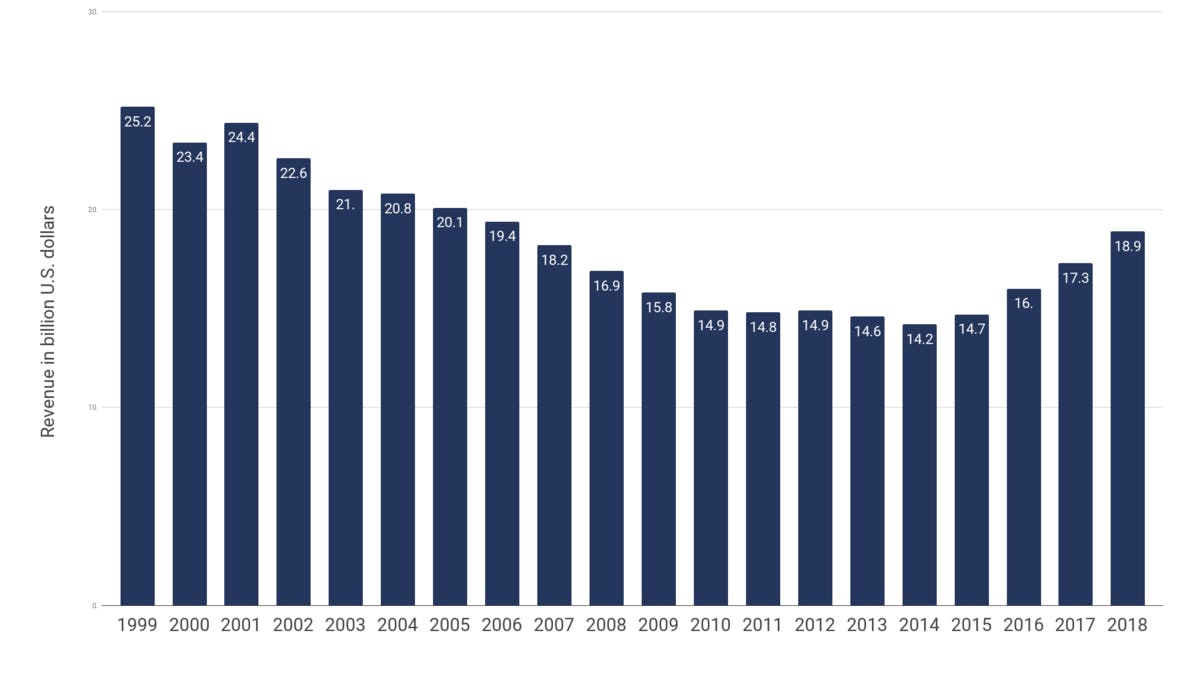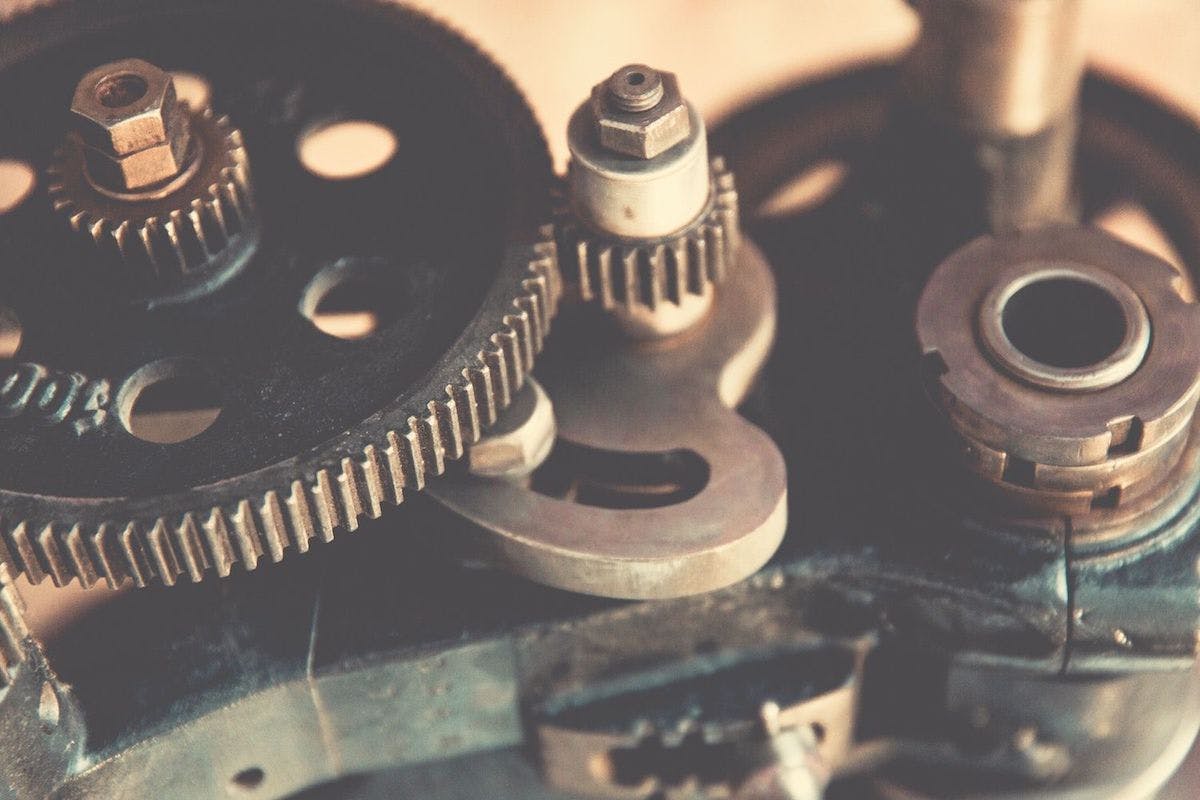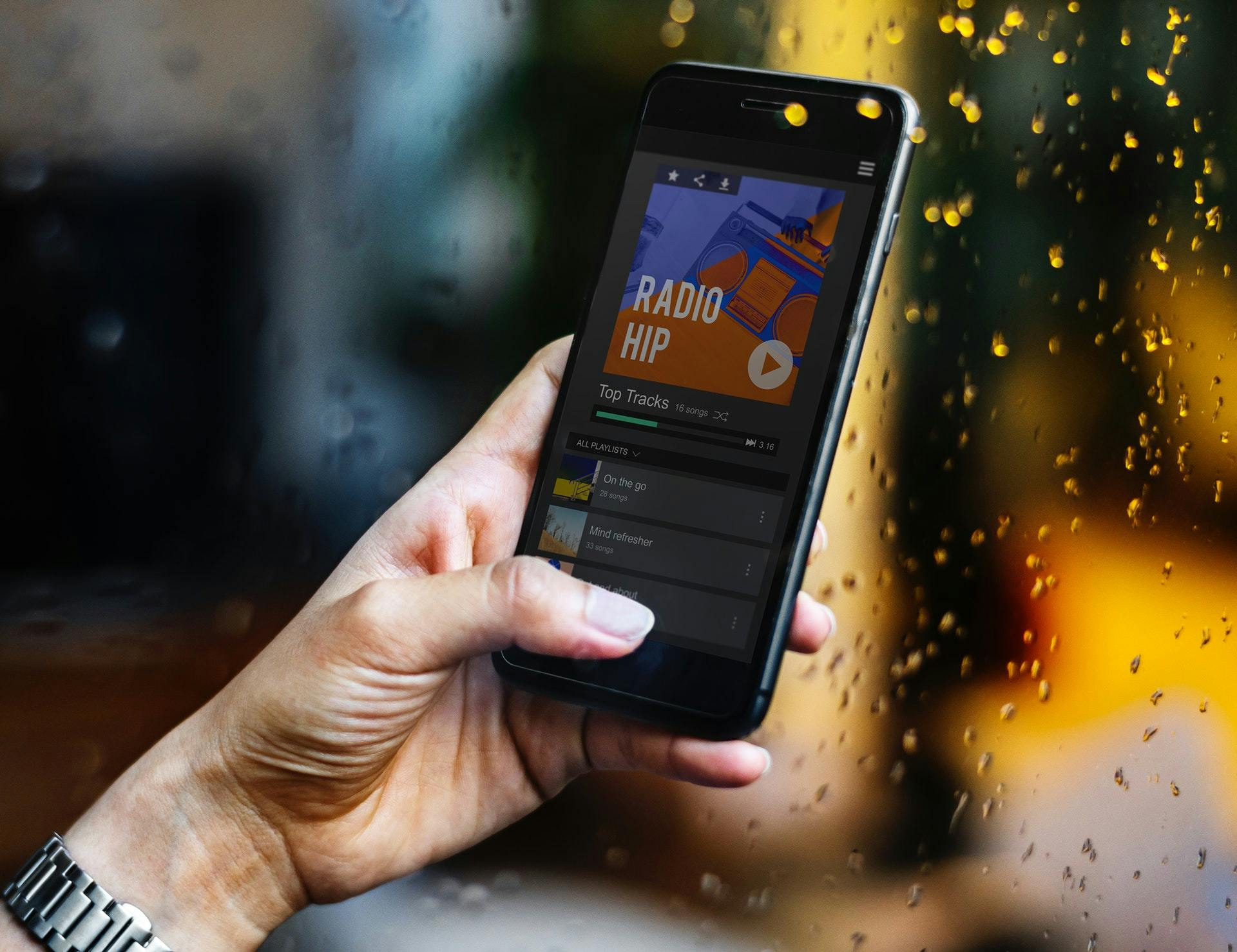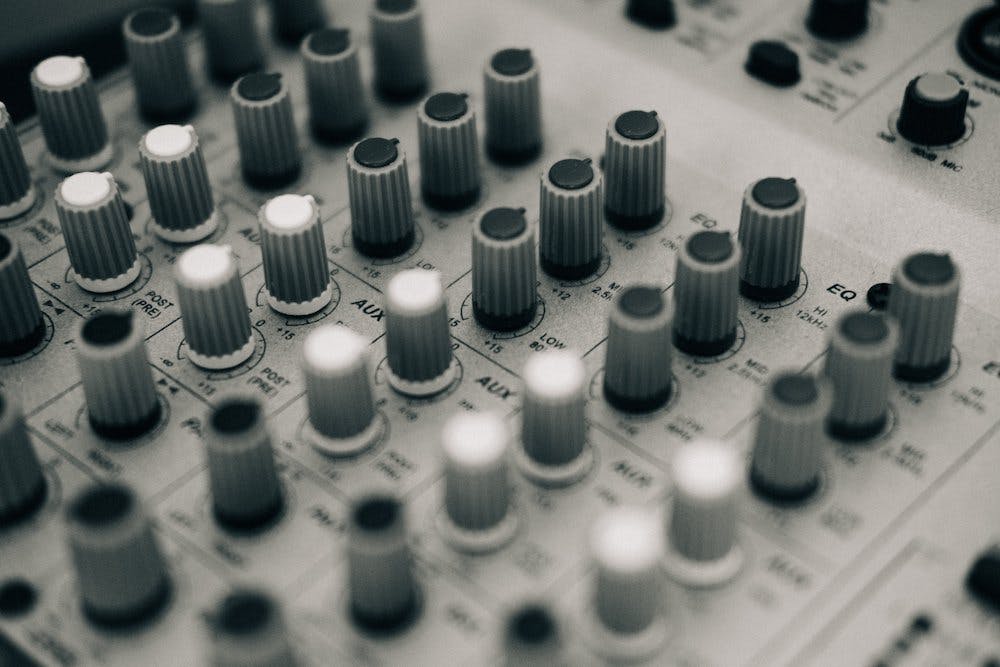Jump to
- Evolution of Artist Career Development
- The 1960s - 2000 - Promotion Carried Out by Record Labels
- 2000-2009 - Dark Days of the Industry and Emerging DIY Promotion
- 2010-2015 - New Digital Promotion Space
- 2015 - … Promotion in the Age of Abundance
- How the Music Industry Works in 10 Key Parts
- 1. Recording Industry
- 2. Digital Music Distribution Industry
- 3. Streaming
- 4. Live and Touring Industry
- 5. Licensing and Sync
- 6. Artist Management
- 7. Music Publishing Industry
- 8. Radio
- 9. Legal
- 10. Audience & Fan Attention
Major artists work with dozens of partners as they tour around the world, release singles, videos and albums, make appearances, sell merch and promote their music and shows. Large careers need large teams to maintain them. The teams of developing acts are usually much, much smaller, but someone still has to support all the revenue streams. So working with young artists means juggling dozens of hats, learning how the music industry works on the go, and expanding your expertise to cover all the holes.
The common denominator for these teams is the fuel that drives them. Artists, managers, independent and major labels, publishers, distributors, promoters, agents, agencies and so on – while not wholly aligned, all those people and companies work towards the same goal. Collaboration is what pushed the industry forward over the decades.
At the same time, each music career is unique, and legislation and business practices differ between countries. So, in the end, the music business is both interconnected and fragmented. That makes it difficult to get a complete, coherent picture of the industry – especially for a newcomer.
That is why we’ve decided to try and lift the veil and explain how the music industry actually works.
In the “Mechanics” series, we will share the knowledge we’ve acquired throughout our careers and the things we’ve learned from all the people we’ve met. We will dissect the individual building blocks of the industry, from legal to recording, and try to show what happens behind the scenes. Sometimes we will have to simplify and take shortcuts to explain things. However, we will always try to keep a neutral voice and focus on facts rather than opinions.
But first, to understand where we are we need to find out how we got here. So, in the next part of this article, we will trace the evolution of the music industry, highlighting the main promotion channels and the way they’ve developed over the years.

Pee Wee Russell Clarinet – Ernie Anderson Publicist on Telephone
Charles Peterson goes to party (1939)
Evolution of Artist Career Development
The 1960s - 2000 - Promotion Carried Out by Record Labels
On the surface, the music industry went through many phases throughout the second half of the 20th century. From the first car tape players in the 60s to the launch of the Sony Walkman and the birth of personalized listening experience in the 80s, technological advancements changed the way listeners experience music. However, while recording formats, genres and generations came and went, the core of the music business remained constant.
The music industry was structured like a straight highway with a few heavily guarded gates along the way. First, artists had to be discovered by labels, which ruled the industry back in the day. Recording companies provided infrastructure, but even more importantly, they had access to the media. Radio and TV were the main promotion channels, and artists needed them to get access to large audiences. Prime-time rotation on a big radio station could bring an overnight success to an artist, propelling them into the life of windfall revenues and nationwide fame. Yet, only a handful of artists enjoyed the benefits of that system, while others were left in the dust.
By the end of the millennium, the tables started to turn. In 1993, the MP3 protocol was invented, allowing to reduce the size of the digital music files up to 95%. MP3 provoked a boom in the digital distribution of music in the early internet era. As Napster (1999) led the way for music piracy and made digital downloads commonplace, the first signs of the future crisis started to show.

Global recorded music revenue from 1999 to 2018, billion U.S. dollars.
Source: MIDIA Research
2000-2009 - Dark Days of the Industry and Emerging DIY Promotion
iTunes was launched in 2001, but even with its integration into Apple's ecosystem, it couldn’t compete with the appeal of free, unlimited music. The old industry was collapsing as the physical distribution, and download-to-own services were losing the battle to online piracy. By 2008, by IFPI estimations, 95% of all digital music was downloaded illegally. At the same time, new-era digital platforms like Myspace (2003), Facebook (2004), Youtube (2005) and Soundcloud (2007) emerged. They brought new ways to monitor success, drawing the industry’s attention to play counts and likes. The first artists of the digital era launched their careers in that chaotic environment: Scooter Braun, for example, discovered Justin Bieber by accidentally clicking on one of his YouTube videos.
The digital economy is agile by definition and soon hundreds of companies offered to boost growth by “hacking” the numbers. In those early days, social media didn’t have the tools to implement marketing campaigns. While Facebook was still focused on viral games like Farmville and tagging pictures of families and friends to generate engagement loops, companies like Topspin (2007) filled the gap. They offered new ways for artists to engage with the digital environment as a hub for artist-fan relationships. So, while revenues were plummeting for everyone, new ways to promote artists emerged.
2010-2015 - New Digital Promotion Space
From 2010 to 2015, the market was at an all-time low. Recording industry revenues went below 15$ billions in 2010 and resided at that level for all five years. On a top side though, the market finally defined its answer to digital piracy. Spotify launched in 2008 and hit the US in 2011. From 2010 to 2015 streaming grew 700%, but it was only the beginning – by May 2014, Spotify had reached only a tenth of its current subscriber count.
Justin Bieber went from the local singing competitions to the most searched person on Google in just three years, and that is something that the industry had to take into account. Recognizing the potential of the new environment, by 2010, most labels already had some sort of a digital department. Influenced by online media, tour marketing and release campaigns started to look the way they are now. The first signs of the direct artist-fan interactions started to appear, and several major artists started their careers around these days by relying on that approach.
2015 - … Promotion in the Age of Abundance
The digital industry has matured, but the physical world is still as vital as it’s ever been. The industry has adapted to the intertwinement of digital and physical worlds and direct artist-fan interactions: artists now stream live shows on their “socials” and announce albums with a single tweet.
Marketing strategies that were traditionally carried out by labels became every man’s game. Publishers, managers and agents invested in the promotion channels, and the industry is now full of digital thinkers, developing careers in the online environment. There are more ways to promote music than there’s ever been, but, at the same time, there is more music itself.
Artists might have direct access to the promotion channels, but more than 20,000 songs are released every day, and the primary challenge of the artist promotion is cutting through that clatter. Music professionals had to become agile and data-driven, feeling at home navigating through the multi-layered and fragmented industry.
How the Music Industry Works in 10 Key Parts
The music industry works through a network of partnerships between companies and individuals on the music creation side (singers, songwriters, and producers), the customer-facing side (streaming platforms, venues and public performance platforms like radio) and the business side, connecting the two (labels, managers, publicists, Performance Rights Organizations, distributors, booking agents and more).
Breaking this structure down in clear terms is exactly the point of our Mechanics project. You see, we often hear the unified term “music industry” thrown around. It can be very deceiving: what may appear to be a single cohesive industry is actually a web of individual parts — sometimes overlapping, other times not. That’s why we’ve decided to give it some structure and dedicate a chapter to each distinct building block we’ve identified. This breakdown is subjective and non-exhaustive, so there are definitely more topics that we could cover. If you have any questions about the industry (specific or otherwise), feel free to reach out to us – it will help us prioritize the future content.
Without further ado, here are the chapters we've focused on:
1. Recording Industry
Record labels suffered the most from piracy in the 2000s. In 15 years, the recording industry went through 3 different realities – from CD to digital piracy to streaming. Labels had to adapt, and the recording business models have changed accordingly. Even today, the recording industry is still facing new challenges – from DIY artist bypassing the labels entirely by working directly with artist aggregators like Soundcloud to the increasing involvement of the artist’s manager in the release promotion.
While the place of the recording industry in the grand scheme of things is changing, labels remain the first thing that comes to mind when people think of the music industry. Most hip-hop fans have heard about Def Jam, EDM fans – of OWSLA and country fans – of Big Machine. Even Universal, Sony and Warner are considered “record labels” by the general population, even though their business model spreads far beyond the scope of a “recording company”, covering all sides of the music business.
Take me to the Mechanics of the Recording Industry
+ Bonus: We've build a model, that allowed us to simulate P&L of a recording release cycle. It's not a part of our Mechanics series per se — but it will be insightful to anyone who want to know how the label really makes money. Check out our analysis here.
2. Digital Music Distribution Industry
Technically, distribution is a part of the recording chain. The core role of distributors is simple: deliver the release to the stores and keep the cash flowing back to the artists and/or their labels. Sounds pretty straightforward, right?
Well, not really. As streaming took over the music industry, the DSPs has become an all-in-one stop for music consumption, monetization, and discovery. The likes of Spotify are not only the platforms for artists to monetize their music but prominent promotion channels. In fact, for 90% of the artists out there the promotional effect of streaming playlists and discovery algorithms is probably more important than the money they get from the streaming services.
Accordingly, distributors industry has become increasingly important as the liaisons between the DSPs and the recording industry, expanding their business model far beyond the core administration and aggregation services.
Take me to the Mechanics of Distribution
3. Streaming
Adoption of streaming is by far the most significant shift in the industry in the last ten years — and that's a shift that is still ongoing. Even today, streaming services are looking for ways to expand their user-base, develop their product, grow the revenues, and find a sustainable long-term business model. The music industry is caught in the middle of that process: streaming has already changed the way the recording industry operates and the way we consume, share and experience music — and that might be just the beginning.
Take me to the Mechanics of Streaming
4. Live and Touring Industry
VR is slowly but surely entering the live industry: with start ups like TheWaveVR and NextVR making a case for the new type of live experience, we might see the industry taking a turn for digitalization soon. For now, however, it remains the 99% “physical”, which also means that it’s the least scalable part of the music business.
There is no difference (from the resource standpoint, at least) between distributing a digital recording to a hundred or a million fans. At the same time, the amount of work that goes into organizing an international tour, reaching the same million fans, is enormous, as the industry remains localized and network-based. It is hard to book a venue in Wellington if you're in Berlin, so most booking agents tend to focus on a single market, and even international players still have to rely on the network of local promoters.
Take me to The Mechanics of Touring.
5. Licensing and Sync
Music has always played an integral role in creative industries like film and video games, while sponsorships deals with musicians are standard practice for brands across all consumer goods sectors, from the Luxury to FMCG. All those connections with external players are managed by the licensing business. Relationships with brands and other mediums are more than just a revenue stream. A fortunate integration can become a major promotional opportunity for the artist – each of us can probably think of a couple of artists, that we’ve discovered in the cinema theater.
Take me to the Mechanics of Licensing and Sync
6. Artist Management
Managers have unique relationships with artists as they are the only partners, who are always aligned with the artists financially. Instead of focusing on a single subset of the industry, managers work on long-term global strategies and help the artists make critical business decisions. Besides, managers coordinate all of the professionals working on the artist’s career — so they need a broad and in-depth knowledge of the entire industry.
Such all-around expertise also means that managers are the best at filling the gaps. Depending on the needs of an artist, managers can replace publishers, dive deep into the record promotion or negotiate live performances. To put it simply, the manager is a jack of all trades and the backbone of any artist's career.
Take me to the Mechanics of Management.
7. Music Publishing Industry
“How do musicians make money?” The answer is not as straightforward as an outsider might think — and publishing is probably the most misunderstood and complex revenue source in the business. A music publisher’s goal is collecting royalty payments on the artist’s rights connected to the actual musical work, and not the recording of it — this is recording industry’s domain.
Already sounds complicated, doesn’t it? Furthermore, royalty payments go through performance rights organizations (aka PROs: ASCAP, BMI, SACEM, and alike), mechanical collections organizations (the HFA in the US, MCPS in the UK), sub-publishers and publishers before actually reaching authors and composers — this process alone can take up to 2 years. Then, there are statutory writer's/publisher's shares, legislative regulations that differ from country to country, fragmented music rights, and a million other nuances and intricacies.
Bottom line is publishing is often obscure even for the experienced music professionals if they’ve never directly worked with the vertical. The fact that Michael Jackson was the primary rights-holder to The Beatles catalog kinda tells you everything you need to know about this facet of the business.
Take me to the Mechanics of Publishing.
8. Radio
The future place of Radio in the music industry is not that clear. The rise of the streaming services also made it far more challenging for radios to reach their audiences – due to the complexity of copyright laws and legal barriers around FM/AM frequencies, even large corporations like iHeart, Bauer Media and SiriusXM can’t offer the worldwide reach of the streaming giants.
However, this local focus is a two-sided coin: while radio can’t compete with streaming on the global scale, it has kept its power as a localized communication channel. Keeping up with the spirit of the time, traditional radio invested heavily into the digital environment. That has opened up new ways for radio to interact with its audience – and, while the radio has lost its status as the primary music discovery medium, it is still a prominent promotional channel and an integral part of the music business.
The Mechanics of Radio are still in the works. Follow us on X to make sure you don't miss it!
9. Legal
Every side of the music business has its own set of commonly accepted rules and regulations, facilitating the relationships between the partners where the law is not explicit. Besides that, local laws, differing from country to country, override those practices if they conflict. At the same time, lawmakers try to develop new solutions to the problems of the digital environment and shed light onto the grey corners of the business. Such initiatives, like the recent article 13 for example, affect the industry as a whole.
As a result, we end up with one of the most globally connected industries, governed by a disconnected system of contracts and legislation. Whether you like it or not, a basic understanding of music law is essential for most music professionals.
The Legal Mechanics of the Music Industry are still in the works. Follow us on X to make sure you don't miss it!
10. Audience & Fan Attention
Relationships between the artist and his fan community are a vital resource for an artist’s career development. Fans were always generating awareness and promoting the artists within their social circles. However, as relationships moved from fan-clubs to social networks over the decades, artist-fans interactions became more crucial than ever. Technology has changed the way artists build relationships with the fans as well as the way fans communicate with each other and the general public. In the Web 2.0 world, fans are the media in itself – one that is sometimes far more effective than traditional channels.
The Mechanics of Attention are still in the works. Follow us on X to make sure you don't miss it!



